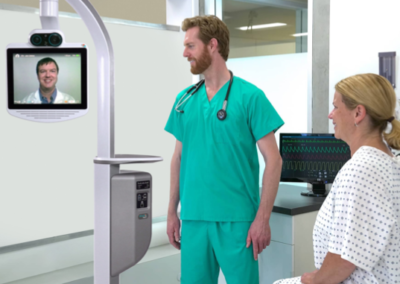‘We’re probably saving 320 to 350 bed days a week at the moment.’
Liz Collison has been working as a Lead Nurse at Queen Elizabeth University Hospital (QEUH) in NHS Greater Glasgow and Clyde Health Board (NHS GGC) in Scotland for 22 years.
The Outpatient Parenteral Antibiotic Therapy (OPAT) pathway was first introduced in Gartnavel General Hospital in 2001. Now based at QEUH, the pathway supports early discharge for patients with complex infections who would otherwise require a long hospital stay. It also provides an alternative to hospital admission for patients with other conditions, such as cellulitis or complicated Urinary Tract Infection (UTI), which require a shorter stay. This pioneering service was covered recently in The Herald, Scotland.
Since May 2022, Liz has been answering Professional-to-Professional Advice calls to the OPAT line from GPs in the area via Consultant Connect. Liz tells us more about the pathway and the benefits to patients and clinicians in the area…
1. Can you tell us about the OPAT service?
‘We are an outpatient service that does a variety of short and long courses of intravenous (IV) antibiotics and complex oral antibiotic treatments that need very close monitoring. OPAT receives referrals from a large variety of inpatient and outpatient settings. Once we receive a referral, an appropriate antibiotic plan is made by the OPAT/ID Consultant.
‘The OPAT nurse specialist team ensure the patient is discharged on this plan with appropriate follow-up or arranged to attend as an outpatient to start the appropriate treatment. Most patients in our service would have been inpatients if it wasn’t for the OPAT pathway.
‘Often, Primary Care clinicians see patients who are not necessarily unwell enough to need to be admitted but need IV antibiotic therapy or more specialist input for complex antibiotic therapy. In the past, they would generally start by referring these patients to the immediate assessment unit. Following this, the patient would be referred to the acute receiving department and then to the wards. What we have been trying to do is cut out the middleman.’
2. Why did you decide to use Consultant Connect?
‘In 2022, our service expanded from five to nine nurse specialists, including the addition of a healthcare support worker and a nurse practitioner. As our service expanded, we looked at ways to facilitate patients coming onto our service by avoiding the front door where possible. That is when we introduced the option for Primary Care clinicians to contact us via Consultant Connect.
‘Primary Care clinicians in NHS GGC were already using the Consultant Connect service for Professional-to-Professional Advice from Secondary Care clinicians across a number of specialties. We added the OPAT pathway as a new specialty to contact via Consultant Connect and informed Primary Care clinicians of the new line. We also put together a Primary Care start-up guide which included advice on the main groups of patients to contact us about, which included skin and soft tissue patients (Cellulitis referrals) as these are patients that quite often will need IV antibiotics.’
3. How has the service developed since its launch?
‘We rolled it out very cautiously at first, giving access just to Primary Care clinicians in the south sector, to begin with, and initially just for cellulitis patients. We began to get a few more referrals, and in the last couple of months, we added patients with urinary tract infections (UTIs) to the pathway. These include symptomatic patients who can’t tolerate oral antibiotics, there are no oral options or they haven’t been responding to oral therapies.
‘We now have two pathways available via the service: a cellulitis pathway, and a UTI pathway.
‘Since we’ve rolled out the UTI pathway, we’ve seen a significant increase in UTI referrals and often more than cellulitis referrals, which was historically the main go-to for any GP with such patients.’
4. What are the volumes of calls that you get through the service
‘We’ve had 69 calls to the team via Consultant Connect since May 2022. However, it is quite unpredictable as it depends on when a Primary Care clinician sees a patient that is suitable for the pathway. We can’t predict infections, so we adapt to what comes our way! It goes through phases, some weeks, we only have a couple of calls, but others, we can get a couple of phone calls a day. Calls only last a few minutes, and as there are a few of us on the rota, we’ve not had to change work plans to accommodate this. If we aren’t available when a call comes through, we know it will automatically divert to the next person on the call answering rota.’
5. Can you share examples of patients you are called about via the service?
‘The most common cases we get called about are lower leg cellulitis, and some of these patients come to the OPAT service for a couple of days of IV therapy which they would have otherwise been admitted for this.
‘There are quite a few patients we get calls about who might have been on our service in the past. Many of these patients are more susceptible to having repeat episodes of UTI and cellulitis, so Primary Care clinicians know they can refer the patients back to us to avoid an admission.
‘For Primary Care clinicians using our service for the first time, they’ll use Consultant Connect to call us, explain the patient case and then we can advise whether the referral to our service is appropriate, if they are suitable for oral antibiotics rather than IV, or if an alternative pathway would be more suited. In these cases, we still know that we’ve taken those patients away from the front door, and we always follow up with them to ensure they don’t come back through the front door, supporting admission avoidance.
‘With UTIs, these patients tend to be more elderly, and if we can avoid them being in hospital then that is preferable to avoid the complications of inpatient treatment. If they’re happy to make the effort of attending once a day for IV therapy, then this also frees up beds for patients who need them.’
6. Do you have any stats on how the service is freeing up beds?
‘We’re probably freeing up hospital beds in the region of 320 to 350 per week at the moment, which has escalated significantly since we expanded the team. So if one patient comes from a Primary Care clinician who has seven days of IV therapy, that is the equivalent of seven bed days saved that week. We are trying to increase our uptake of avoided admissions to try to help ease pressure on the hospitals.
‘In time, we hope to expand the criteria we give to Primary Care clinicians, maybe looking to expand it to other areas like bronchiectasis patients or osteomyelitis.’
If you have any questions about this service, please get in touch on 01865 261467 or at hello@consultantconnect.org.uk.




